Case Study of Amazon.com: Analysis of Business Strategies
VerifiedAdded on 2021/04/21
|8
|1591
|987
Case Study
AI Summary
This case study provides an in-depth analysis of Amazon.com, examining its evolution from an online bookstore to a global e-commerce leader. It explores the challenges faced by the company, including the near-bankruptcy in 2001, and the strategic decisions that led to its success. The case study highlights key lessons learned, such as the importance of a robust business model, strategic partnerships, and customer-centric approaches. It also examines recommendations for future growth, including infrastructure changes and adapting to competitive market dynamics. The analysis covers Amazon's expansion into various business models and the impact of its mergers and partnerships, such as with Toys "R" Us. The study concludes by emphasizing the significance of customer growth and the company's ability to overcome obstacles to achieve its current market position.

Running head: CASE STUDY OF AMAZON.COM
Case study of Amazon.com
Name of the Student
Name of the University
Author note
Case study of Amazon.com
Name of the Student
Name of the University
Author note
Paraphrase This Document
Need a fresh take? Get an instant paraphrase of this document with our AI Paraphraser
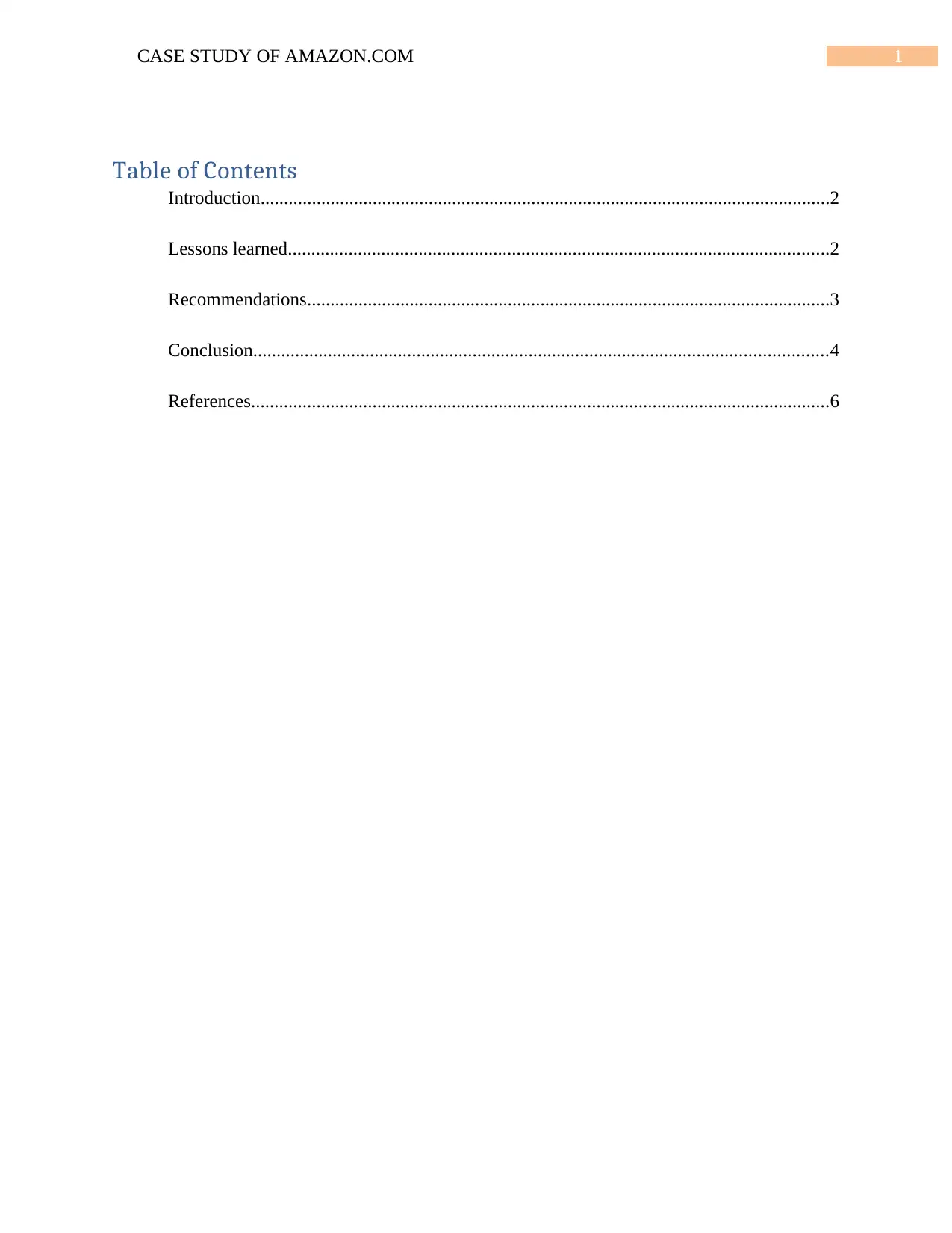
1CASE STUDY OF AMAZON.COM
Table of Contents
Introduction..........................................................................................................................2
Lessons learned....................................................................................................................2
Recommendations................................................................................................................3
Conclusion...........................................................................................................................4
References............................................................................................................................6
Table of Contents
Introduction..........................................................................................................................2
Lessons learned....................................................................................................................2
Recommendations................................................................................................................3
Conclusion...........................................................................................................................4
References............................................................................................................................6
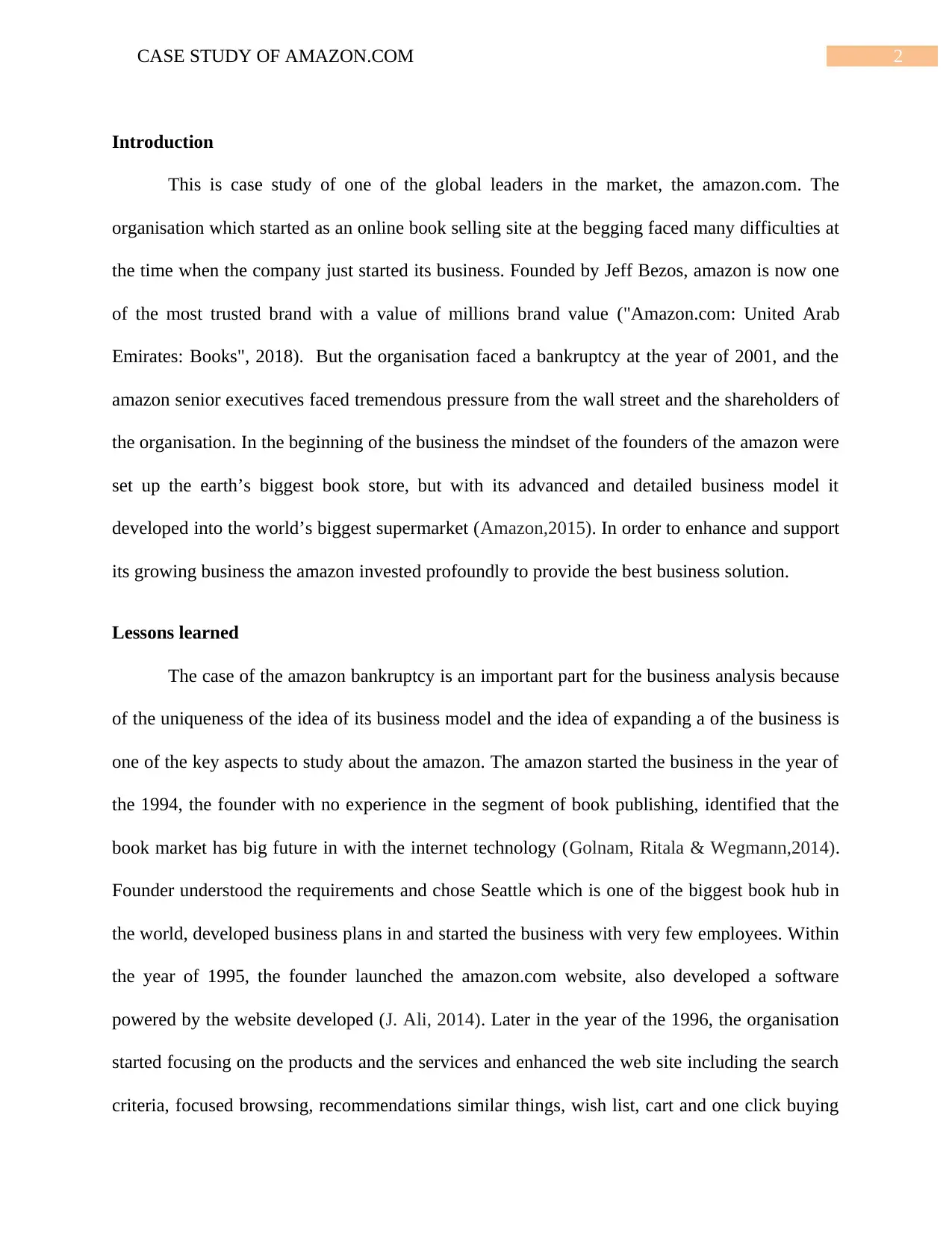
2CASE STUDY OF AMAZON.COM
Introduction
This is case study of one of the global leaders in the market, the amazon.com. The
organisation which started as an online book selling site at the begging faced many difficulties at
the time when the company just started its business. Founded by Jeff Bezos, amazon is now one
of the most trusted brand with a value of millions brand value ("Amazon.com: United Arab
Emirates: Books", 2018). But the organisation faced a bankruptcy at the year of 2001, and the
amazon senior executives faced tremendous pressure from the wall street and the shareholders of
the organisation. In the beginning of the business the mindset of the founders of the amazon were
set up the earth’s biggest book store, but with its advanced and detailed business model it
developed into the world’s biggest supermarket (Amazon,2015). In order to enhance and support
its growing business the amazon invested profoundly to provide the best business solution.
Lessons learned
The case of the amazon bankruptcy is an important part for the business analysis because
of the uniqueness of the idea of its business model and the idea of expanding a of the business is
one of the key aspects to study about the amazon. The amazon started the business in the year of
the 1994, the founder with no experience in the segment of book publishing, identified that the
book market has big future in with the internet technology (Golnam, Ritala & Wegmann,2014).
Founder understood the requirements and chose Seattle which is one of the biggest book hub in
the world, developed business plans in and started the business with very few employees. Within
the year of 1995, the founder launched the amazon.com website, also developed a software
powered by the website developed (J. Ali, 2014). Later in the year of the 1996, the organisation
started focusing on the products and the services and enhanced the web site including the search
criteria, focused browsing, recommendations similar things, wish list, cart and one click buying
Introduction
This is case study of one of the global leaders in the market, the amazon.com. The
organisation which started as an online book selling site at the begging faced many difficulties at
the time when the company just started its business. Founded by Jeff Bezos, amazon is now one
of the most trusted brand with a value of millions brand value ("Amazon.com: United Arab
Emirates: Books", 2018). But the organisation faced a bankruptcy at the year of 2001, and the
amazon senior executives faced tremendous pressure from the wall street and the shareholders of
the organisation. In the beginning of the business the mindset of the founders of the amazon were
set up the earth’s biggest book store, but with its advanced and detailed business model it
developed into the world’s biggest supermarket (Amazon,2015). In order to enhance and support
its growing business the amazon invested profoundly to provide the best business solution.
Lessons learned
The case of the amazon bankruptcy is an important part for the business analysis because
of the uniqueness of the idea of its business model and the idea of expanding a of the business is
one of the key aspects to study about the amazon. The amazon started the business in the year of
the 1994, the founder with no experience in the segment of book publishing, identified that the
book market has big future in with the internet technology (Golnam, Ritala & Wegmann,2014).
Founder understood the requirements and chose Seattle which is one of the biggest book hub in
the world, developed business plans in and started the business with very few employees. Within
the year of 1995, the founder launched the amazon.com website, also developed a software
powered by the website developed (J. Ali, 2014). Later in the year of the 1996, the organisation
started focusing on the products and the services and enhanced the web site including the search
criteria, focused browsing, recommendations similar things, wish list, cart and one click buying
⊘ This is a preview!⊘
Do you want full access?
Subscribe today to unlock all pages.

Trusted by 1+ million students worldwide
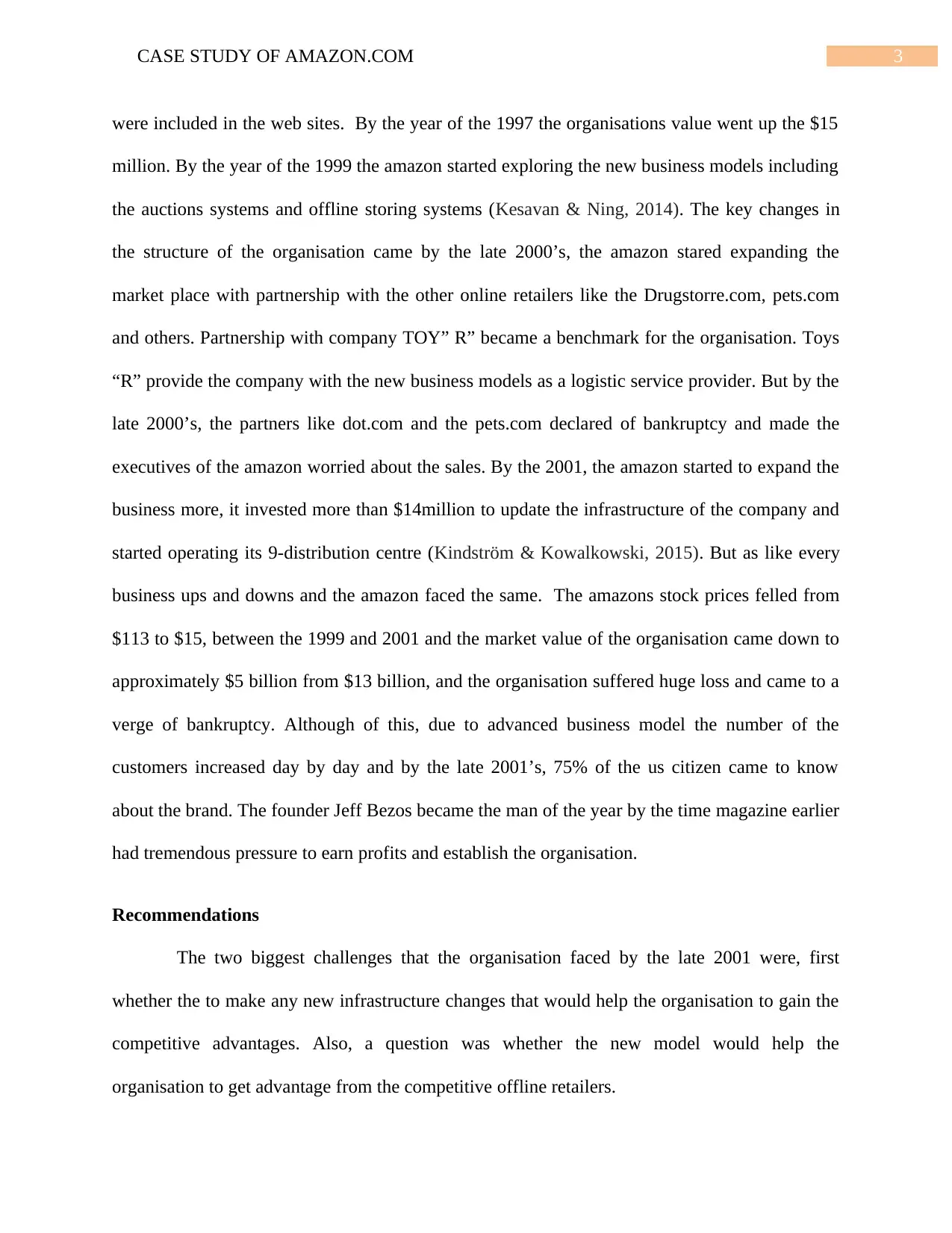
3CASE STUDY OF AMAZON.COM
were included in the web sites. By the year of the 1997 the organisations value went up the $15
million. By the year of the 1999 the amazon started exploring the new business models including
the auctions systems and offline storing systems (Kesavan & Ning, 2014). The key changes in
the structure of the organisation came by the late 2000’s, the amazon stared expanding the
market place with partnership with the other online retailers like the Drugstorre.com, pets.com
and others. Partnership with company TOY” R” became a benchmark for the organisation. Toys
“R” provide the company with the new business models as a logistic service provider. But by the
late 2000’s, the partners like dot.com and the pets.com declared of bankruptcy and made the
executives of the amazon worried about the sales. By the 2001, the amazon started to expand the
business more, it invested more than $14million to update the infrastructure of the company and
started operating its 9-distribution centre (Kindström & Kowalkowski, 2015). But as like every
business ups and downs and the amazon faced the same. The amazons stock prices felled from
$113 to $15, between the 1999 and 2001 and the market value of the organisation came down to
approximately $5 billion from $13 billion, and the organisation suffered huge loss and came to a
verge of bankruptcy. Although of this, due to advanced business model the number of the
customers increased day by day and by the late 2001’s, 75% of the us citizen came to know
about the brand. The founder Jeff Bezos became the man of the year by the time magazine earlier
had tremendous pressure to earn profits and establish the organisation.
Recommendations
The two biggest challenges that the organisation faced by the late 2001 were, first
whether the to make any new infrastructure changes that would help the organisation to gain the
competitive advantages. Also, a question was whether the new model would help the
organisation to get advantage from the competitive offline retailers.
were included in the web sites. By the year of the 1997 the organisations value went up the $15
million. By the year of the 1999 the amazon started exploring the new business models including
the auctions systems and offline storing systems (Kesavan & Ning, 2014). The key changes in
the structure of the organisation came by the late 2000’s, the amazon stared expanding the
market place with partnership with the other online retailers like the Drugstorre.com, pets.com
and others. Partnership with company TOY” R” became a benchmark for the organisation. Toys
“R” provide the company with the new business models as a logistic service provider. But by the
late 2000’s, the partners like dot.com and the pets.com declared of bankruptcy and made the
executives of the amazon worried about the sales. By the 2001, the amazon started to expand the
business more, it invested more than $14million to update the infrastructure of the company and
started operating its 9-distribution centre (Kindström & Kowalkowski, 2015). But as like every
business ups and downs and the amazon faced the same. The amazons stock prices felled from
$113 to $15, between the 1999 and 2001 and the market value of the organisation came down to
approximately $5 billion from $13 billion, and the organisation suffered huge loss and came to a
verge of bankruptcy. Although of this, due to advanced business model the number of the
customers increased day by day and by the late 2001’s, 75% of the us citizen came to know
about the brand. The founder Jeff Bezos became the man of the year by the time magazine earlier
had tremendous pressure to earn profits and establish the organisation.
Recommendations
The two biggest challenges that the organisation faced by the late 2001 were, first
whether the to make any new infrastructure changes that would help the organisation to gain the
competitive advantages. Also, a question was whether the new model would help the
organisation to get advantage from the competitive offline retailers.
Paraphrase This Document
Need a fresh take? Get an instant paraphrase of this document with our AI Paraphraser
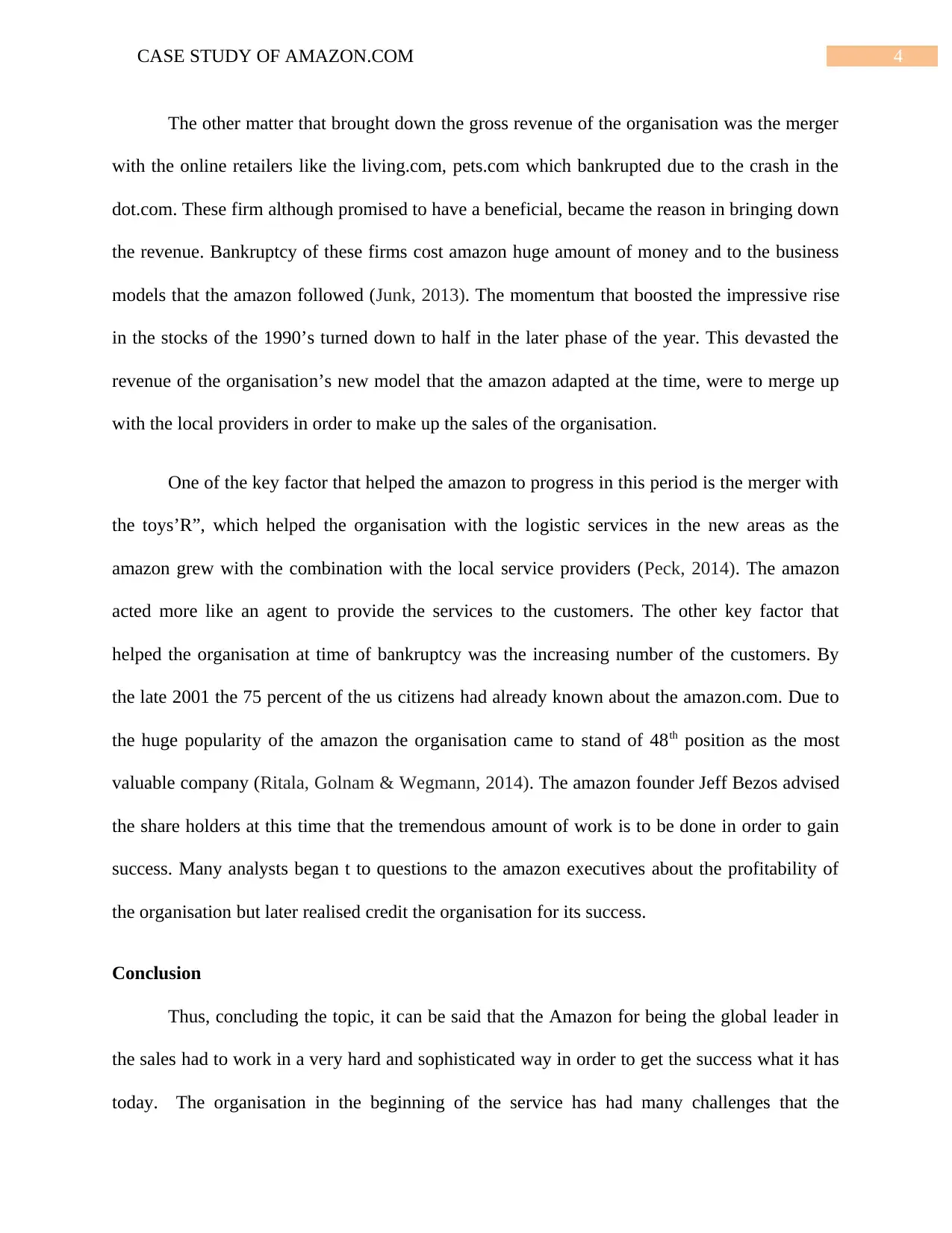
4CASE STUDY OF AMAZON.COM
The other matter that brought down the gross revenue of the organisation was the merger
with the online retailers like the living.com, pets.com which bankrupted due to the crash in the
dot.com. These firm although promised to have a beneficial, became the reason in bringing down
the revenue. Bankruptcy of these firms cost amazon huge amount of money and to the business
models that the amazon followed (Junk, 2013). The momentum that boosted the impressive rise
in the stocks of the 1990’s turned down to half in the later phase of the year. This devasted the
revenue of the organisation’s new model that the amazon adapted at the time, were to merge up
with the local providers in order to make up the sales of the organisation.
One of the key factor that helped the amazon to progress in this period is the merger with
the toys’R”, which helped the organisation with the logistic services in the new areas as the
amazon grew with the combination with the local service providers (Peck, 2014). The amazon
acted more like an agent to provide the services to the customers. The other key factor that
helped the organisation at time of bankruptcy was the increasing number of the customers. By
the late 2001 the 75 percent of the us citizens had already known about the amazon.com. Due to
the huge popularity of the amazon the organisation came to stand of 48th position as the most
valuable company (Ritala, Golnam & Wegmann, 2014). The amazon founder Jeff Bezos advised
the share holders at this time that the tremendous amount of work is to be done in order to gain
success. Many analysts began t to questions to the amazon executives about the profitability of
the organisation but later realised credit the organisation for its success.
Conclusion
Thus, concluding the topic, it can be said that the Amazon for being the global leader in
the sales had to work in a very hard and sophisticated way in order to get the success what it has
today. The organisation in the beginning of the service has had many challenges that the
The other matter that brought down the gross revenue of the organisation was the merger
with the online retailers like the living.com, pets.com which bankrupted due to the crash in the
dot.com. These firm although promised to have a beneficial, became the reason in bringing down
the revenue. Bankruptcy of these firms cost amazon huge amount of money and to the business
models that the amazon followed (Junk, 2013). The momentum that boosted the impressive rise
in the stocks of the 1990’s turned down to half in the later phase of the year. This devasted the
revenue of the organisation’s new model that the amazon adapted at the time, were to merge up
with the local providers in order to make up the sales of the organisation.
One of the key factor that helped the amazon to progress in this period is the merger with
the toys’R”, which helped the organisation with the logistic services in the new areas as the
amazon grew with the combination with the local service providers (Peck, 2014). The amazon
acted more like an agent to provide the services to the customers. The other key factor that
helped the organisation at time of bankruptcy was the increasing number of the customers. By
the late 2001 the 75 percent of the us citizens had already known about the amazon.com. Due to
the huge popularity of the amazon the organisation came to stand of 48th position as the most
valuable company (Ritala, Golnam & Wegmann, 2014). The amazon founder Jeff Bezos advised
the share holders at this time that the tremendous amount of work is to be done in order to gain
success. Many analysts began t to questions to the amazon executives about the profitability of
the organisation but later realised credit the organisation for its success.
Conclusion
Thus, concluding the topic, it can be said that the Amazon for being the global leader in
the sales had to work in a very hard and sophisticated way in order to get the success what it has
today. The organisation in the beginning of the service has had many challenges that the
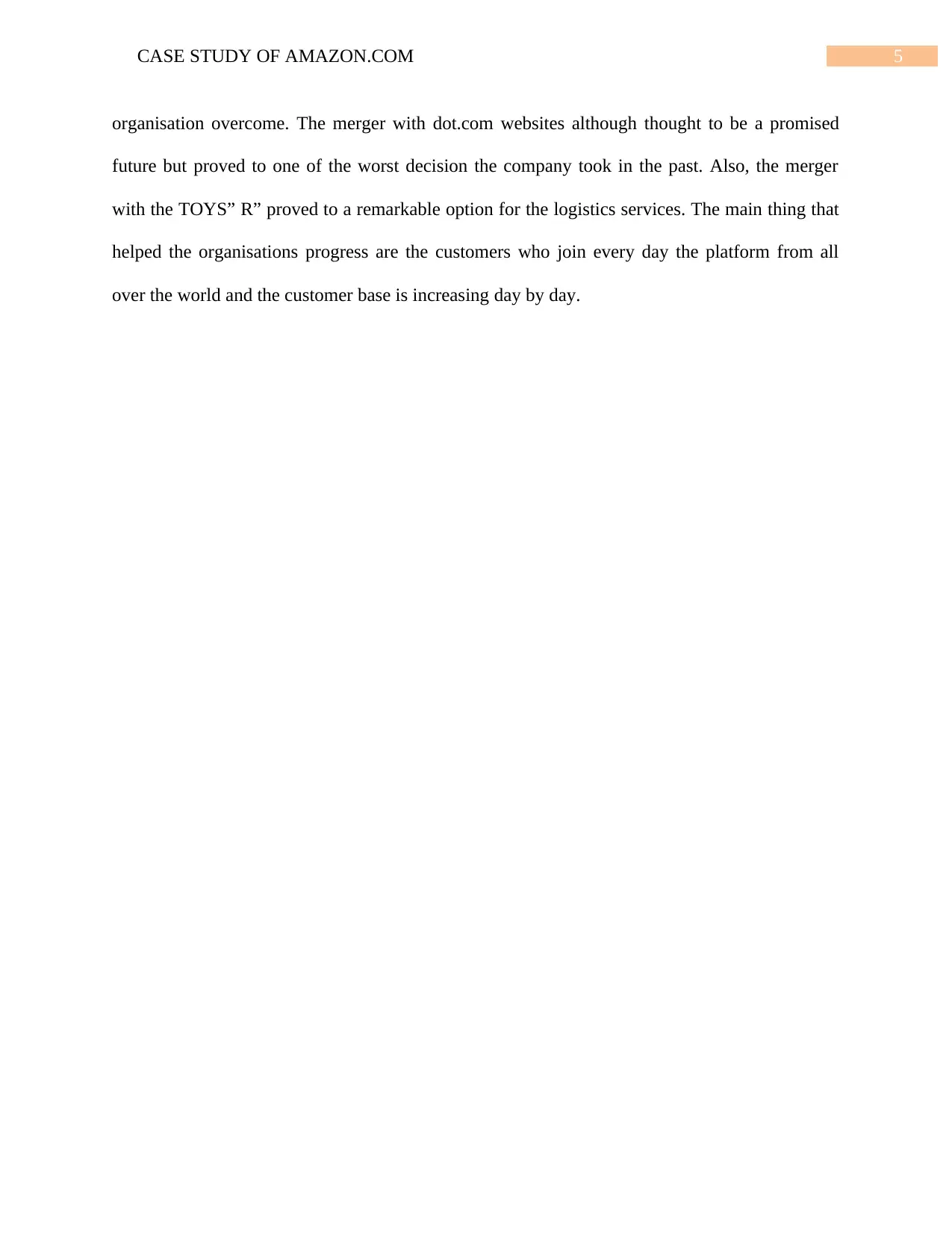
5CASE STUDY OF AMAZON.COM
organisation overcome. The merger with dot.com websites although thought to be a promised
future but proved to one of the worst decision the company took in the past. Also, the merger
with the TOYS” R” proved to a remarkable option for the logistics services. The main thing that
helped the organisations progress are the customers who join every day the platform from all
over the world and the customer base is increasing day by day.
organisation overcome. The merger with dot.com websites although thought to be a promised
future but proved to one of the worst decision the company took in the past. Also, the merger
with the TOYS” R” proved to a remarkable option for the logistics services. The main thing that
helped the organisations progress are the customers who join every day the platform from all
over the world and the customer base is increasing day by day.
⊘ This is a preview!⊘
Do you want full access?
Subscribe today to unlock all pages.

Trusted by 1+ million students worldwide
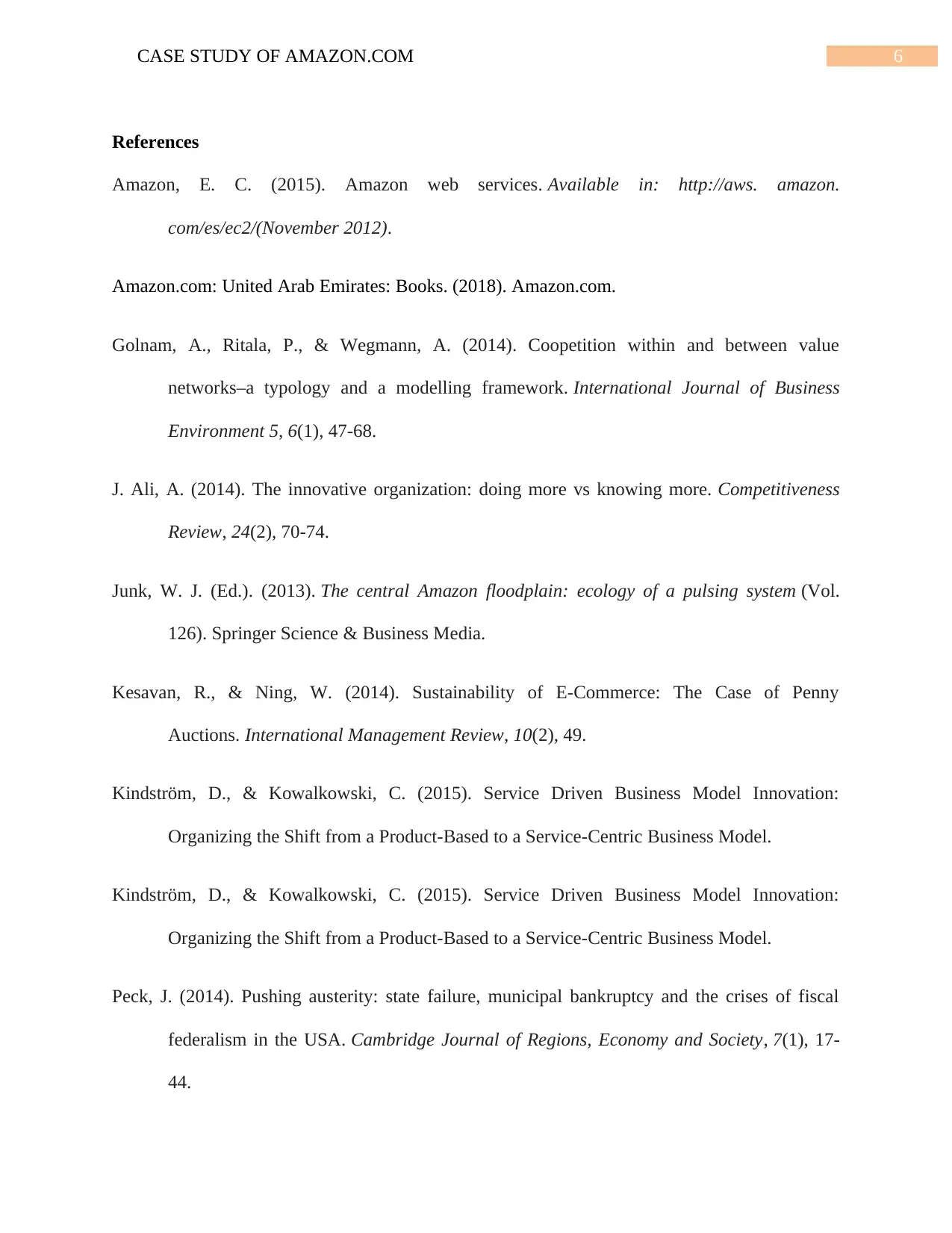
6CASE STUDY OF AMAZON.COM
References
Amazon, E. C. (2015). Amazon web services. Available in: http://aws. amazon.
com/es/ec2/(November 2012).
Amazon.com: United Arab Emirates: Books. (2018). Amazon.com.
Golnam, A., Ritala, P., & Wegmann, A. (2014). Coopetition within and between value
networks–a typology and a modelling framework. International Journal of Business
Environment 5, 6(1), 47-68.
J. Ali, A. (2014). The innovative organization: doing more vs knowing more. Competitiveness
Review, 24(2), 70-74.
Junk, W. J. (Ed.). (2013). The central Amazon floodplain: ecology of a pulsing system (Vol.
126). Springer Science & Business Media.
Kesavan, R., & Ning, W. (2014). Sustainability of E-Commerce: The Case of Penny
Auctions. International Management Review, 10(2), 49.
Kindström, D., & Kowalkowski, C. (2015). Service Driven Business Model Innovation:
Organizing the Shift from a Product-Based to a Service-Centric Business Model.
Kindström, D., & Kowalkowski, C. (2015). Service Driven Business Model Innovation:
Organizing the Shift from a Product-Based to a Service-Centric Business Model.
Peck, J. (2014). Pushing austerity: state failure, municipal bankruptcy and the crises of fiscal
federalism in the USA. Cambridge Journal of Regions, Economy and Society, 7(1), 17-
44.
References
Amazon, E. C. (2015). Amazon web services. Available in: http://aws. amazon.
com/es/ec2/(November 2012).
Amazon.com: United Arab Emirates: Books. (2018). Amazon.com.
Golnam, A., Ritala, P., & Wegmann, A. (2014). Coopetition within and between value
networks–a typology and a modelling framework. International Journal of Business
Environment 5, 6(1), 47-68.
J. Ali, A. (2014). The innovative organization: doing more vs knowing more. Competitiveness
Review, 24(2), 70-74.
Junk, W. J. (Ed.). (2013). The central Amazon floodplain: ecology of a pulsing system (Vol.
126). Springer Science & Business Media.
Kesavan, R., & Ning, W. (2014). Sustainability of E-Commerce: The Case of Penny
Auctions. International Management Review, 10(2), 49.
Kindström, D., & Kowalkowski, C. (2015). Service Driven Business Model Innovation:
Organizing the Shift from a Product-Based to a Service-Centric Business Model.
Kindström, D., & Kowalkowski, C. (2015). Service Driven Business Model Innovation:
Organizing the Shift from a Product-Based to a Service-Centric Business Model.
Peck, J. (2014). Pushing austerity: state failure, municipal bankruptcy and the crises of fiscal
federalism in the USA. Cambridge Journal of Regions, Economy and Society, 7(1), 17-
44.
Paraphrase This Document
Need a fresh take? Get an instant paraphrase of this document with our AI Paraphraser

7CASE STUDY OF AMAZON.COM
Ritala, P., Golnam, A., & Wegmann, A. (2014). Coopetition-based business models: The case of
Amazon. com. Industrial Marketing Management, 43(2), 236-249.
Ritala, P., Golnam, A., & Wegmann, A. (2014). Coopetition-based business models: The case of
Amazon. com. Industrial Marketing Management, 43(2), 236-249.
1 out of 8
Related Documents
Your All-in-One AI-Powered Toolkit for Academic Success.
+13062052269
info@desklib.com
Available 24*7 on WhatsApp / Email
![[object Object]](/_next/static/media/star-bottom.7253800d.svg)
Unlock your academic potential
Copyright © 2020–2025 A2Z Services. All Rights Reserved. Developed and managed by ZUCOL.




